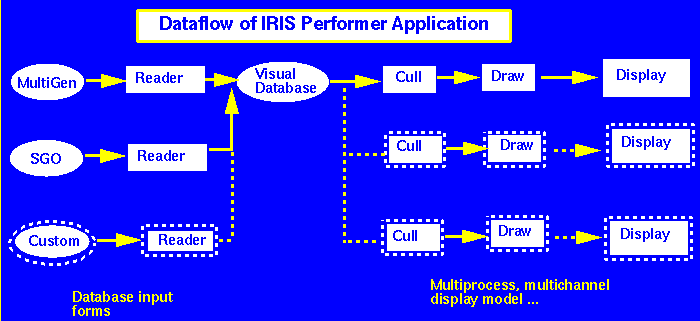IRIS Performer (tm)
A Simulation Oriented Software Development Environment
IRIS Performer is a software development environment for
programmers
implementing high-performance graphics applications on Silicon
Graphics systems.
It offers high-level support for visual simulation virtual reality
and
graphics intensive tasks without compromising the IRIS (r) heritage
of power
performance and portabllity.
Power
The outer layer of IRIS Performer implements the specific needs
of visual simulation applications. It performs culling, assuring
that only potentially viewable geometry is sent to the graphics
hardware; it controls multiple display channels; it provides fast
intersection tests with simulation databases; and most
importantly,
it orchestrates all of this in parallel with rendering on multi-
processor
IRIS system configurations.
Performance
The inner core of IRIS Performer is a rendering
executive designed for maximum performance. Data structures
efficiently utilize the CPU, cache, and memory system architecture;
tuned rendering loops convert the system CPU into an optimized data
management engine; and state management control minimizes overhead
and
retains flexibility.
Portability
IRIS Performer offers a high-performance
portability path across the Silicon Graphics product line.
Since the low-level library is implemented as a hardware specific
shared
library, applications based on IRIS Performer can achieve optimal
graphics
rates on the full range of IRIS products without changes
or recompilation.
IRIS Performer is an economical and productive starting
point for graphics application developers. It provides
comprehensive support for advanced visual image generation tasks
layered above a flexible and portable rendering library. This
combination
does more than speed the development of sophisticated graphics
applications, it also assures that the result will execute at
optimal
performance on any Silicon Graphics (tm)system.
Features
- Rapid generation of real-time graphics based applications
- Application compatibility across IRIS system, optimal
performance for
product range with each platform
- Powerful range of high-level simulation features
- Optimized rendering and scene management performance
- Implements a multiprocessor environment
- System and application timing control utilities ensure
deterministic
frame-rate control
- Load management utilities enable manipulation of large data
sets
- Level of detail fading and control
- Application diagnostic and tuning utilities
- Display list management
- Sample applications with source code
The Application Library - LIBPF Provides Comprehensive Visual
Simulation Capabilites

The IRIS Performer library-libpf, provides software support
targeted directly at realtime visual simulation. It addresses
the needs of both conventional image generation and emerging
applications such as virtual reality. Major libpf facilities
support
hierarchial scene construction, multiple channels, culling to each
channel's field of view, rapid intersection tests (e.g.: collision
detection),
frame-rate control and multiprocessing support.
A unique feature of libpf is its "data fusion architecture".
Rather than converting databases into a common format, libpf
provides
the ability to define database specific filters that can seamlessly
upload a wide variety of independent database formats.
LIBPF Functionality
- Hierarchical visual database
- Multiprocessing control
- Multi-channel support
- Multi-pipeline support
- System load management
- Fade level of detail switching
- Intersection and collision testing
- Dynamic and static coordinate systems
- Culling for display efficiency
- Database feedback queries
- Environment control for clouds and fog
- Animation sequences
The Performance Libary- LIBPR - Provides Optimal Rendering
Performance
The core of IRIS Performer is libpr, the performance rendering
library.
It is an application-neutral layer that supports the graphic,
system, and hardware control needs of visual applications. The
core of libpr is an efficient state tracking and control system
that
eliminates redundant mode changes, and a collection of highly tuned
rendering loops that convert the system CPU into an optimized data
movement engine. In addition, libpr includes portable functions to
access hardware-specific features, such as high-resolution timers.
LIBPR Functionality
- High-speed rendering
- State management and mode control
- Display list rendering




